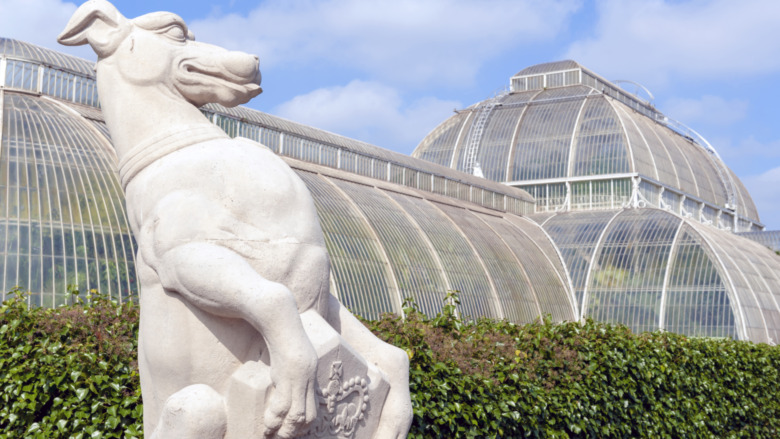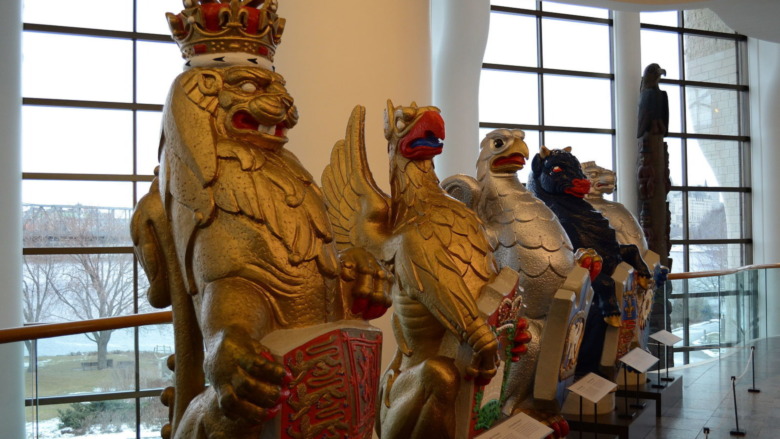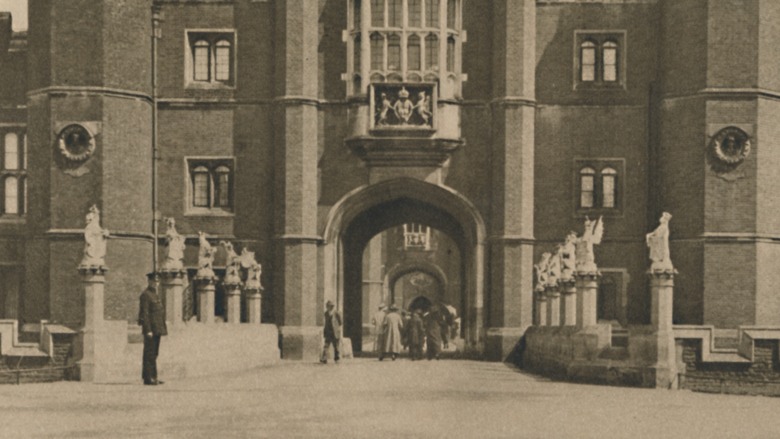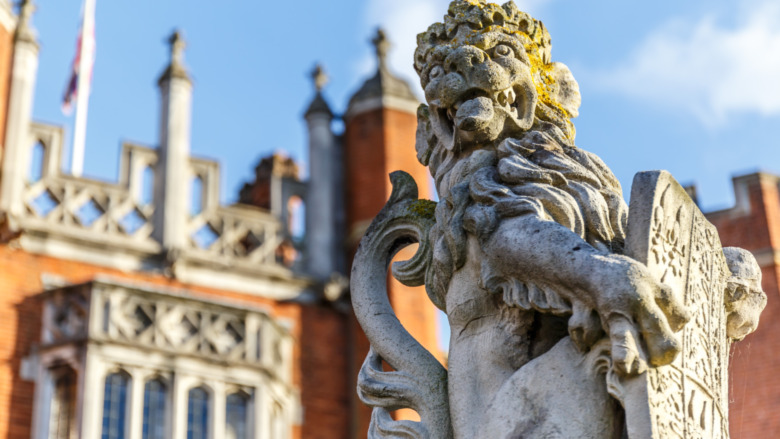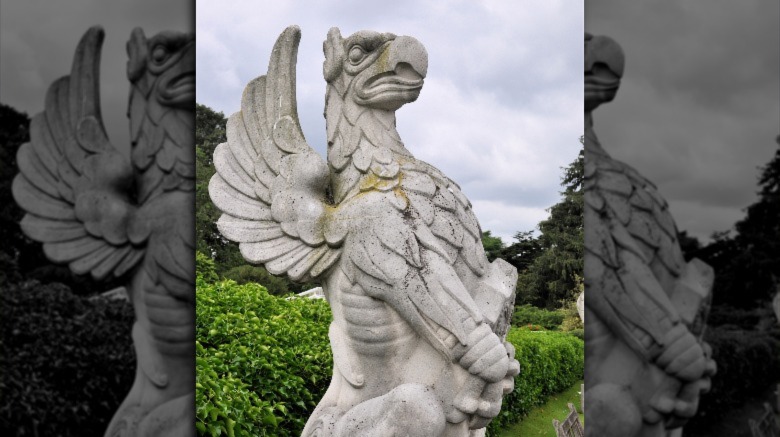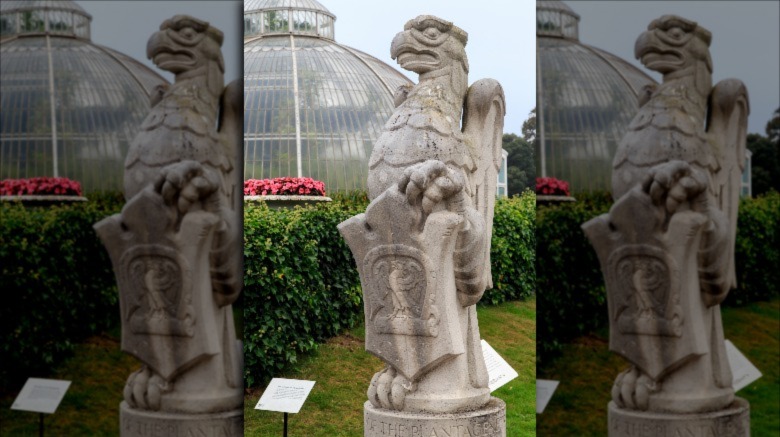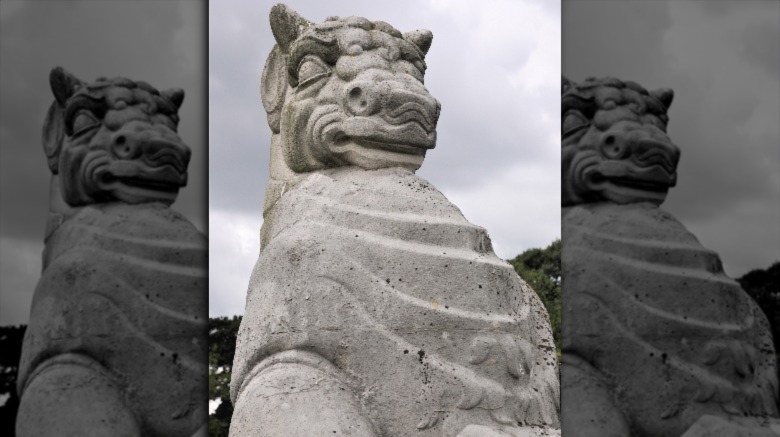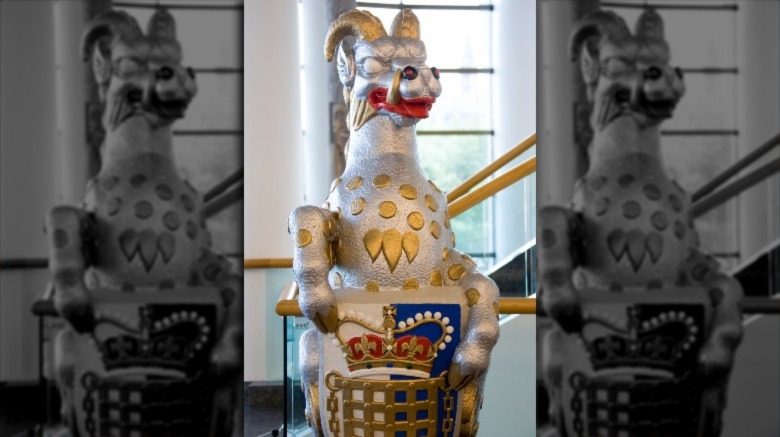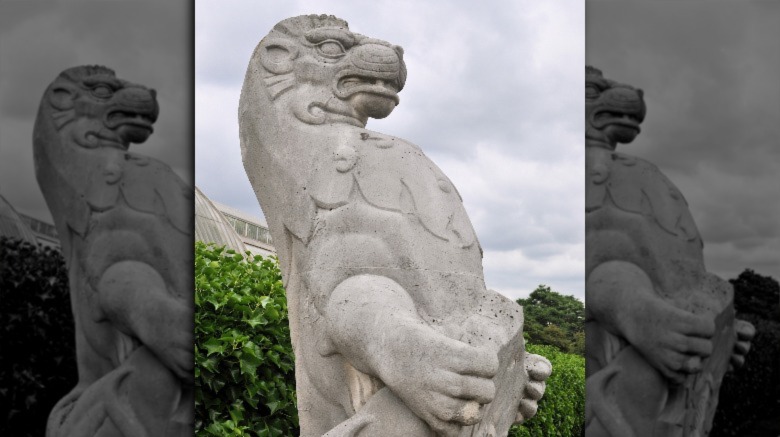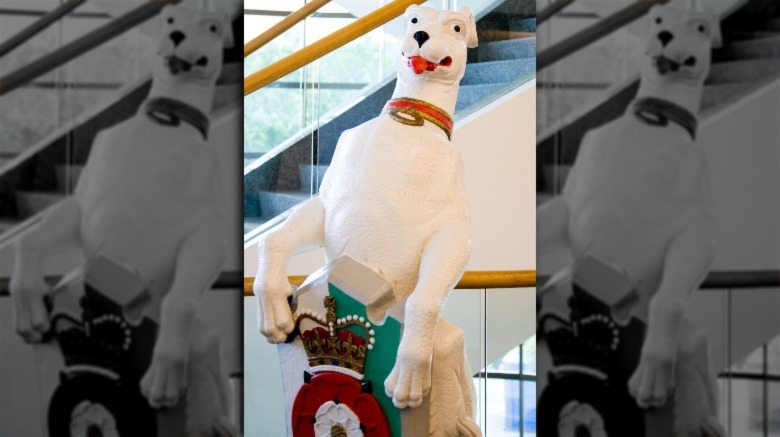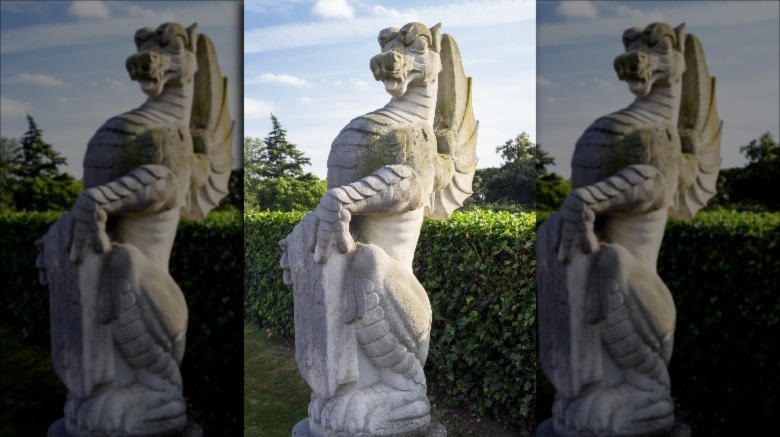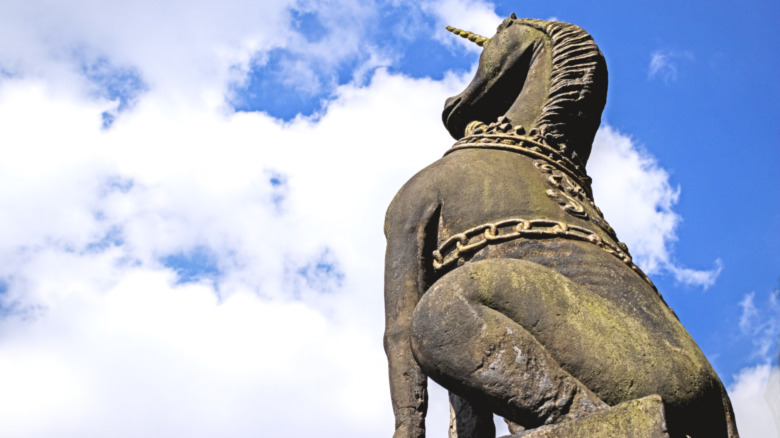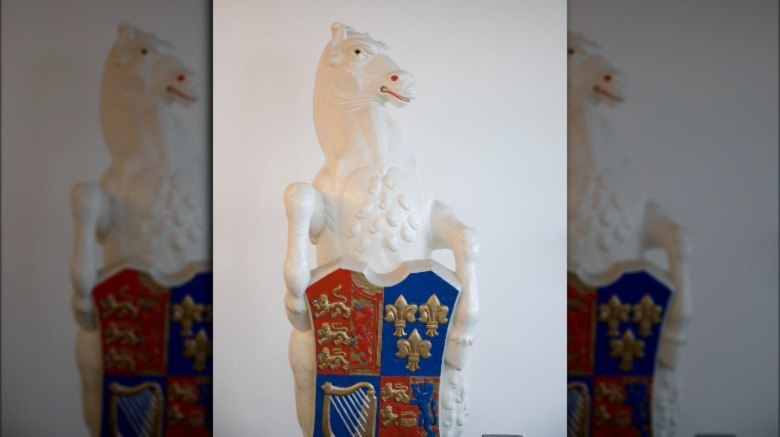What Are The Queen's Beasts? We Explain
Heraldry is almost ridiculously complicated, and studying it means learning words like saltire, rampant and statant, passant guardant... basically, it's pretty intense. Fortunately, it's entirely possible to appreciate heraldry without sitting through a three-hour lecture.
All anyone really needs to know is this: Heraldry, says English Heritage, first showed up in the 12th century. That's when knights started wading onto the battlefield covered from head to toe in armor, and with their faces hidden beneath helmets, it was next to impossible to tell who was under there. (Unless it's the Mountain. Pretty sure he's going to be recognized with or without all that armor.) In order to guarantee they were going to be recognized, knights started painting their shields with their own personal coat of arms. Each knight's needed to be unique, and over the centuries that's given rise to a wide range of designs, animals, shapes, colors, and patterns — and necessitated the need for those absurdly complicated descriptors we mentioned earlier.
There are tons of different heraldic devices, and there are some that have become not just symbols of their families, but symbols of English nobility. And that's where the Queen's Beasts come in.
The history of the heraldic statues
Britain's Queen Elizabeth II was officially crowned on June 2, 1953 — and it wasn't the first coronation she'd been to: that was her father's, 16 years before. (It's almost unbelievable, but The Royal Household says that there's been 900 years' worth of coronations at Westminster Abbey, and the roots of the service go all the way back to 973.) Present at the coronation were a set of 10 plaster statues created by James Arthur Woodford RA, OBE; according to Mapping Sculpture, Woodford's other creations can be seen all across England, and include a redesigned Royal Coat of Arms.
The Queen's Beasts are 10 creatures — some real, some mythical — that were plucked from the heraldic coats of arms of Elizabeth II's ancestors. The Royal Botanic Gardens Kew says that "together they symbolize the various strands of royal ancestry," and that these particular images were chosen because they best represent her "legitimacy as heir." The original set of beasts (pictured, in part) aren't in England anymore — they're in the Canadian Museum of History in Quebec. Why? After being moved to Windsor, the powers-that-be decided that they were going to be given to one of England's commonwealths as a gift — and Canada was chosen.
Visitors to England can still see them, though: In 1956, Woodford made another set in stone, and they were installed outside the Palm House at Kew.
They were inspired by the King's Beasts
The idea of a set of heraldic creatures made to represent the lineage of a monarch didn't start with Elizabeth II's Queen's Beasts — according to Windsor Castle and the College of St. George, the King's Beasts that originally stood watch from the Chapel roof dated back to the Tudor era. Those original statues were taken down during the renovations of Sir Christopher Wren — the architect who, the BBC says, was the driving force behind the rebuilding and redesign of London after the Great Fire in 1666.
It wasn't until the 1920s that the King's Beasts — in the form of 76 statues that included 14 different creatures — were sculpted in the old Tudor style and re-installed. (Some of the surviving originals can be seen at Hampton Court.)
Some of the King's Beasts are also included in the Queen's Beast — and those are creatures like the yale and the unicorn, and real animals like the falcon, the lion, and the greyhound. Not seen in the Queen's set is a swan, an antelope, a panther, and a white hart. The overlap is no coincidence, though: These original King's Beasts were chosen to represent the lineage of King Henry VIII and Jane Seymour, who would be his third wife (via Kew).
The Lion of England
According to The Royal Mint, the oldest of the Queen's Beasts is the lion. That first started being associated with the English monarchy way back in 1127, when Henry I gifted the imagery to Geoffrey Plantagenet on his marriage to the king's daughter. That original shield was blue and the lions were gold, and throughout the generations, lions have remained strongly associated with the nobility as a symbol of strength and bravery. Once Richard I used lions for his royal arms, they hung around pretty consistently.
Three lions are seen a lot, and according to the BBC, that was first used by King Henry II. But... when is a lion not a lion? When it's a leopard, and here's where things get tricky.
The lions of English heraldry don't all look like lions, and History Extra says that's because some are a creature called a leopard — and no, that's not the same as the leopards we all know and love. The mythological leopards of heraldry were thought to be half lion (i.e., leo-) and half something called a pard... which was a mythical creature first described by Pliny in around the year 77. By the 13th century they had become a little demonic, says Atlas Obscura, and that circles back around to the idea that they're creatures born of forbidden, adulterous love. While they were common symbols for the clergy to adopt, they were also for royalty.
The griffin of Edward III
Many have heard the lion called — for some reason — the King of the Jungle, and when it comes to the air, it's the eagle that has the same lofty reputation. And that, says The Royal Mint, is where the griffin comes into the Queen's Beasts. After appearing in heraldic symbols pretty regularly right from the beginning, it was originally elevated into a symbol of the nobility by Edward III. And it makes sense: It's a creature that combines the most powerful creature on land with the most powerful bird of the air, and if there's anything that symbolizes royalty, it's that far-reaching rule.
Griffins have been rubbing elbows with the all-powerful for a long time. Folklore Thursday says they showed up in ancient Greece pulling Apollo's chariot, and that firmly established their link with the life-giving sun. They were also associated with Nemesis — which made them guardians — and were credited with possessing not just the courage and strength of the lion, but the speed and intelligence of the eagle. Interestingly, there's another theory that suggests that the combination of the two was also used to sort of symbolically represent conflict between the various powerful houses of medieval Europe.
Also, here's a fun fact: Heraldic griffins with wings are always female. Males have no wings — instead, they're depicted as emitting the sun's rays, and they're usually sporting horns.
The falcon of the Plantagenets
The Plantagenet dynasty ruled from 1154 — when the marriage of King Henry II to Eleanor of Aquitaine united England and huge sections of France under one rule — to 1399. (Or arguably until 1485, and the death of Richard III.) Project Britain says they include famous names like King Richard the Lionheart and King John, who signed the Magna Carta.
And they're the branch of the royal family tree that gives Elizabeth II the falcon to include in the Queen's Beasts. According to The Royal Mint, the falcon was first used as a royal heraldic symbol by Edward III, who chose it in part because he really, really liked the rich guy sport of hawking. (Hawking, says PBS, was governed by a strict set of rules at the time, and the bird someone was allowed to keep and fly depended on their social status. Only the king could fly a gyrfalcon, and it was also Edward III who made the theft of a trained bird a crime worthy of a death sentence.)
The symbol of the falcon was passed down through his line, along with a gold lock (that's meant to represent the theoretically unbroken line of succession). The falcon was front and center during the War of the Roses, too — and when Henry VII united the two houses, he took the Yorkist falcon as one of his own symbols.
The black bull of Clarence
Americans might think of the Wall Street bull when they think of the symbolism of these magnificent creatures, and strangely, that's not entirely far removed from the bull's importance in England. According to The Royal Mint, the bull is a member of the Queen's Beasts thanks to Edward IV. He was England's first king from the House of York, and he shared the symbol with his brother, who would become Richard III. The bull was chosen by the Yorkist rulers for an association with characteristics like strength, passion, and courage, and here's where the financial connection comes in.
When Elizabeth I assumed the throne, the Royal Museums Greenwich says she inherited a system of coins that's best described as "a mess." Henry VIII's habit of minting coins that contained next to no actual gold and silver had left only pretty worthless coins in circulation, and Elizabeth ordered a complete overhaul of England's currency and a re-minting of all coins. A year later, they were back in business — and one of the designs on these new Elizabethan coins — which successfully revalued English currency — was a bull's head.
They're also not the first to use the bull as a symbol of strength, as History Today says that archaeologists have found evidence that suggests there was a "bull cult" that thrived during the Bronze Age.
The yale of Beaufort
There's one of the Queen's Beasts that looks like it might be some sort of antelope, but it's not — it's a mythical creature called a yale, and The Royal Mint says it's long been associated with graceful strength and determination. And yes, it's the same creature that Yale University took their name from, in honor of the mythical animal's connection with education and curiosity.
The yale has been around for a long time — according to Theoi, it was once thought to be a hippo-sized creature that lived in what we now call Ethiopia. In addition to massive tusks, it also had long horns that it could move independently.
So, how does this weird creature with the rotating antlers get connected to Queen Elizabeth II? Through Henry VII's mother, Lady Margaret Beaufort. The Beaufort yale — unlike more traditionally-described yales that are brown or black — was white with gold spots, which Chards says was used to symbolize the white robes worn by clergy and the Beaufort's very literal gold: they were one of the richest houses of the time. Margaret herself was known to be a devout Catholic, and at the same time, she was instrumental in putting her son on the throne and — afterwards — establishing two colleges at Cambridge. The yale, then, is a fitting symbol for someone so dedicated to both her faith and education... along with ensuring the family's standing.
The white lion of Mortimer
There are a few lions in the ranks of the Queen's Beasts, and no, it's not just multiple depictions of really important animals. The second lion is the white lion of Mortimer, and it's the one that's not wearing a crown. While the lion of England represents ferocity, The Royal Mint says that the white lion represents a different kind of strength: discipline and loyalty.
The first one to use the white lion was Knight of the Order of the Garter co-founder Roger Mortimer, and there's some fascinating history that suggests why he may have wanted to stress that whole "loyalty" thing. He would eventually become the 2nd earl of March, and it was his grandfather — also named Roger Mortimer — who was the 1st earl of March... and who Britannica says was hanged as a traitor after conspiring to get rid of King Edward II. The elder Roger was arrested and thrown in the Tower of London before fleeing to France amid (correct) implications that he'd had something to do with the king's murder. Things looked even shadier when the dead king's wife, Queen Isabella, fled to France to join him (yes, they were lovers), and he was so hated his peers turned on him, captured him, shipped him back to the Tower, and had him executed.
Later, after the 2nd earl of March adopted the white lion of loyalty, the Yorkist white rose and the sun's rays were added to the shield.
The white greyhound of Richmond
Anyone with a dog can relate to the symbolism of the white greyhound: According to The Royal Mint, greyhounds have long been an invaluable part of royal households for their use in hunting. That goes back to the 12th century — alongside the origins of heraldry — and for nearly as long, the greyhound has represented not just loyalty and faithfulness, but skill, physical fitness, elegance, and wealth.
It was Edward III who first elevated the greyhound to a royal symbol, and included the image of the dog on the 1360 Bretigny Seal. Even though other kings decided to swap the greyhound out for a bull, Edward III's descendants continued to use the greyhound in various forms — right through to the Tudors, where it represented the earldom of Richmond. And that, in turn, was used by Henry VII to illustrate his combination of Lancastrian and Tudor lineage, and cement his claim to the throne.
The University of Cambridge says that the greyhound became one of the "heraldic symbols of the Tudors' right to rule," and it's continued to represent the legitimacy of royal rulers... making it a valuable addition to the Queen's Beasts.
The red dragon of Wales
The red dragon has been a symbol of Wales for a long, long time — and it's an homage that's served by the dragon's inclusion in the Queen's Beasts. The story is a fascinating one, and according to the BBC, Wales has been using the red dragon as a symbol of their nation and people since at least 655 — and possibly even longer. It's thought that the popularity of the dragon goes back to the 5th century, but historians say that it wasn't until the 12th century that we get the story that's most popularly associated with the red dragon and Wales.
Visit Wales says that the story started with a Celtic king named Vortigern; when he was looking for a place to build his castle, he found what he thought was the perfect spot. A boy — sometimes said to be Merlin — warned him that if he built in the spot he'd chosen, he was going to disturb two dragons that were sleeping in an underground lake. Vortigern, of course, didn't listen to the kid, and when the two dragons woke, they fought. The red triumphed over the other, and that's been said to represent a few things — including the imminent arrival of King Arthur, and the triumph of the Welsh people in battle.
So, the red dragon came to represent Wales, and here's a fun fact: There really is an underground lake near that mythical spot.
The unicorn of Scotland
The oddest of the Queen's Beasts might be the unicorn, which was included to represent Scotland.
The unicorn is, indeed, the national animal of Scotland, but they're not talking about the kind of unicorn that sparkles or has a deep connection with Tom Cruise. The National Trust for Scotland says that yes, while the unicorn has been a symbol of innocence and purity since ancient mythology first started telling tales about these horned horses, there's much more to it. Unicorns are nearly impossible to capture and completely impossible to tame — they're "fiercely independent and famously difficult to capture or conquer," and that's where the connection with the Scottish people comes in.
The unicorn has been associated with Scotland since the mid-16th century, and here's a fascinating tidbit: originally, Scotland's coat of arms featured two unicorns, and it wasn't until Scotland's King James VI — who was also King James I of England — that one of the unicorns was turned into the English lion. There's a strange bit of mythological foreshadowing here — according to popular folklore, the unicorn and the lion are ferocious enemies, both claiming to be the king of all beasts.
The white horse of Hanover
The white horse of the Queen's Beasts goes back to a time of massive change: when Queen Anne died in 1714, it marked the end of the Stuarts. That's when King George I took the throne, and he brought with him the white horse of Hanover.
The white horse of his Royal Arms became an important symbol of Britain's acceptance of the new monarchy, says The Royal Mint — it's also why there are so many pubs called "The White Horse" that date to George I's rule. The horse showed up elsewhere, too: It became the symbol of the Order of the Bath and the Hanoverian Guelphic Order, and it was also present on the era's military uniforms.
There's a good reason for that, too. Dating well back into ancient mythology, white horses have been seen as symbols of wisdom, intelligence, spirit, and speed. White horses feature in the legends of the Celtic gods, with characters like the Welsh Rhiannon known for riding an Otherworldly white horse (via TransCeltic). It was first adopted as a heraldic symbol in 1361, but by then, they'd already been considered sacred animals for nearly 2,000 years.
